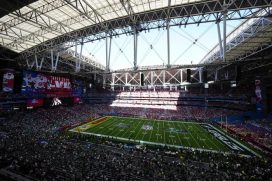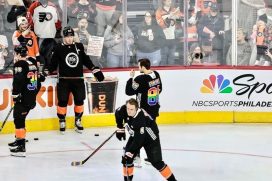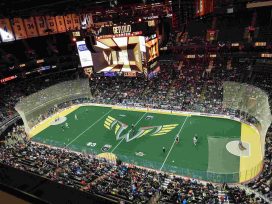Patrick Causey, on Twitter @PhillySportsJD
I like to rank top prospects in tiers: franchise to all-star caliber players, potential all stars to starters; starters to potential role players; and role players. On average, each draft will have 1-2 players in the franchise category, 2-3 in the all star category, approximately 10 starters, and approximately 25 role players. The remaining players end up as busts or washing out of the league in 2-3 years, sometimes even less.
While this draft class is not as top heavy as last year's, it is arguably deeper. The strength of this draft class lies in the second and third categories. There are quite a few guys that project to be NBA caliber starting players in this draft.
I am not going to cover every projected first round prospect. Here are my top 20 players.
Franchise – All Star players
1. Jahlil Okafor, C, Duke: I am a big Okafor fan. And if I had to put money down, I would pick Okafor as the guy that emerges as the best player from this draft. His low post game is so advanced, and his footwork so impressive, that I think Okafor's floor is a 20/10 guy. While he is not an explosive athlete, his offensive game has shades of Tim Duncan. I also think concerns about his defense are over blown. Yes, his block rate was low. But when Okafor was keyed in, he showed that he can be an adequate to good defender. That should be enough for him to be a franchise caliber player.
2. D'Angelo Russell, PG, OSU: Russell could be a perfect floor general for today's NBA. He shot an impressive 41% from deep in college, and scouts have compared his passing ability and vision to Chris Paul. He is not the best athlete, and slacks off on defense too often. But just look at Steph Curry and James Harden, two players who were also knocked for their athleticism and defense, to see how much that could hold Russell back. Check out my in-depth scouting report on Russell here.
Potential All Stars-Starters
3. Karl Anthony-Towns, C, UK: surprised he's not number one? I know I'm in the minority, but I have my reservations about KAT's game. I get why he is the prohibitive favorite to be picked number one. 7'0 footers that have the potential to become elite two-way players are incredibly hard to find. While KAT is an elite shot blocker, I don't see any other skills that project at the elite level; at least yet. And while it is important to have rim protectors in today's NBA, they can be found much later in the draft. KAT is a good defender, but his propensity to get in foul trouble could be an issue down the road, and I wonder whether his defensive prowess was overblown a little because he played on a Kentucky team that was absolutely loaded with elite defenders. I am also concerned that his offensive game might not be as dominant as people are projecting. Yes, he looks incredible in individual workouts. But so do a lot of draft prospects. I am not sure he is going to be able to stretch the floor consistently; he did not do it at Kentucky at all. He has a very good sky hook, but his low post moves are somewhat marginal after that, and he needs to improve his footwork as well. One other thing to be concerned with: his running style. He is not a smooth runner; he labors up and down the court reminiscent of Greg Oden and Andrew Bynum. It might mean nothing; but 7'0 footers with that running style should give you pause for concern. He will likely go number one because NBA teams cannot help themselves when it comes to 7'0 footers with two-way potential. And if he puts it all together, he will be the best player out of this draft, without question. But there is an awful lot of projection going on here, which gives me pause for concern.
4. Emmanuel Mudiay, PG, China: If Mudiay played in college last year, he might be the prohibitive favorite to be picked number one. He has elite athleticism, is a plus defender, and can get to the rim at will. Which explains why Larry Brown compares him to John Wall. But not many teams have seen Mudiay play since high school. This uncertainty is likely going to cost him come draft day. If Mudiay can become a consistent shooter, the sky is the limit. If he cannot, he will likely be a Tyreke Evans type player; a good but not great combo guard. Check out my in-depth scouting report on Mudiay here.
5. Justise Winslow, SG/SF, Duke: I wrote about Winslow earlier this week, so I won't belabor my point. I think he has a chance to be a better offensive player, but not as elite of a defender, as Kawhi Leonard. He is an athletic wing that can get to the rim with ease and can guard multiple positions on the other end of the floor. If he can continue to improve his shooting and scoring ability, watch out. He could end up as the steal of this draft.
6. Mario Hezonja, SF, Croatia: Credit Derek Bodner for turning me on to Hezonja. He is a 6'8 athletic wing with a sweet stroke and the ability to guard multiple positions. These skills make him an ideal fit for the modern NBA. I don’t think he could ever become the lead guy on a franchise, but he could be a good second option for a team. And if Embiid can ever stay healthy, Hezonja could provide the floor spacing and slashing ability that prevents defenses from keying on Embiid.
7. Kristaps Porzingis, C, Latvia: Porzingis has the highest disparity between his floor and his ceiling. He can either be a perennial All-Star in the mold of Dirk Nowitzki, or a complete bust like Jan Vesely. He is a 7'0 big with athleticism and a sweet stroke. f defenses close too hard on his shot, he can blow by them with his explosive first step and leaping ability. He also has impressive steal (1.5) and block (2.0) rates per 40 minutes. But he has many of the same limitations as other European bigs that have flamed out in this league: he avoids contact around the lane, is not very big, lacks low post moves, and is not a great rebounder. It's not entirely fair to compare him to other European busts that came before him; but I would be disappointed if the Sixers grabbed him at number three.
Starters – Rotation Players
8. Trey Lyles, PF, UK: for the life of me, I cannot figure out why Lyles isn't higher on people's draft boards. He is an extremely skilled 6'10, 240 pound power forward that can take his man off the dribble and get to the rim at ease. He is an ideal big for when a team plays small ball. The concerns around his game seem to be three-fold: his college production, his defense and athleticism. His production was limited by playing out of position as a small forward on the historically deep Kentucky team. And while he is not going to jump out of a gym, athleticism sometimes can be over blown. He has drawn comparisons to Al Horford and Carlos Boozer, two perennial All-Star power forwards in their prime. Given his skill level, I think he should carve out a similar career. If I were to make one bold prediction, it would be this: Lyles will have the best career out of any player on that Kentucky team, Karl Anthony-Towns included.
9. Willie Caulie-Stein, C, UK: Larry Bird thinks WCS can be a $100 million man. And it's not hard to see why. He is a freak athlete and projects to be one of the best defensive centers in the NBA in short order. He is an excellent shot blocker, can guard multiple positions, and excels at covering the pick-and-roll. If he can develop a consistent offensive game, he just might earn that $100 million after all.
10. Sam Dekker, SF, Wisc.: Dekker has shades of Gordon Hayward to his game. Dekker is a slash and kick specialist, with good athleticism, crafty moves, and above average passing ability to wreck havoc when he gets into the lane. Stay home on the shooters and he will get to the bucket; crash on his drive and he will spot the open man for a three. He is a strong rebounder for a wing and has the ability to grab a board and start the fast break on his own. He is also a good defender; as he can guard multiple positions and is disciplined in his defensive rotations. Dekker needs to improve his three point shooting, as he went from shooting 39% from beyond the arc his freshman year to just 31% last season. If he can become more consistent from beyond the arc, he could project higher. But for now, expect a starter/solid rotation player career out of him.
11. Stanley Johnson, SF, Arz: Johnson does not lack confidence, that's for sure. The Arizona swing man recently declared himself the best player in this draft. He is 6'7, 245 lbs, with an impressive 6'11.5 wing span. Johnson has one of the better combinations of size, speed and strength of any player in this draft. He is a more polished offensive player than Winslow, and can guard multiple positions on the other end of the floor. The knock on Johnson is his finishing at the rim, lack of vertical explosion, and consistency.
12. Kelly Oubre Jr., SF, KU: Oubre is one of the more polarizing prospects in this entire class. Some question his love of the game and lack of production at Kansas. However, if he can put it all together, he will be a prototypical "3 and D" specialist, which is incredibly valuable in today's NBA. He is 6'7 with a ridiculous 7'2 wingspan. Those are Kawhi Leonard numbers, folks. He has a very nice jump shot, with a soft touch and the ability to hit from deep. He needs to improve his consistency and shot selection to reach his full potential.
13. Myles Turner, C, Tex: Turner is 6'11.5, with a good shooting stroke (he shot an impressive 83.9% from the free throw line), and elite rim protection skill. In fact, his blocks per game(2.4) were more than KAT (2.2). However, he has an awkward running style that gives scouts concerns about his long term health. Because he is such a good shooter, he has a tendency to play too much on the perimeter. He lacks the post moves of other bigs in this class, and has a tendency to get pushed off the block too often. But his standing reach (9'4) suggests he can become a great rebounder with added strength.
Rotation Players – Specialists
14. Jerian Grant, PG, ND: I am a fan of Grant, who is the brother of Sixers Jeremi Grant. He possesses good size, instincts and passing ability for a point guard. He is a good creator, both for himself and others. And he projects as a good defender at the NBA level. The knocks on Grant are his age (22), and his shooting consistency. He likely won't ever develop into a top flight point guard, but he could have a good career in the league.
15. Frank Kaminsky, C, Wisc.: Kaminsky is a skilled, versatile big man that should turn out to be a solid rotational player for an NBA team. What he lacks in explosive athleticism he makes up for in a good array of low post moves. He is an adequate rebounder, and can stretch the floor with his shooting ability. However, he struggles against length and athleticism, which should limit his ceiling in the NBA.
16. Rondoe Hollis-Jefferson, SG/SF, Arz.: Hollis-Jefferson is arguably the best defensive wing in this draft. Just ask D'Angelo Russell how difficult it is to score against him. Hollis-Jefferson shut Russell down during the NCAA tournament. If Hollis-Jefferson could shoot, he would likely be a top 10 pick in this draft. At worst, teams are getting an elite wing defender, which is invaluable in today's NBA. At his best, he becomes a key cog on a championship caliber team as a 3 and D specialist.
17. Devin Booker: Others are much higher on Booker than I am, with several draft websites projecting him as a top 10 pick. I do not think his talent level justifies the draft spot. He is arguably the best shooter in this class, with picture perfect form and a compact release. But outside of that, I don't see any definitive NBA skills. He is not an explosive athlete, struggles on the defensive side of the ball, and does not create his own shot off the dribble. Perhaps he can prolong his career much like J.J. Reddick did by getting into great shape; but right now, I don't see much to his game besides his shot beyond the arc.
18. Tyus Jones, PG, Duke: Jones is a cerebral point guard that has plus passing ability. While he is not a physically imposing player (he stands at 6'2), and is only an average athlete, he does not lack confidence. Some have compared him to Utah's point guard Trey Burke as a result; which is a fair comparison. He will never be a super star, but he figures to be a solid point guard.
19. Cameron Payne, PG, Murray State: Payne has shot up draft boards based on his athleticism, vision, and scoring touch. But I think some people might be getting a little carried away looking for the next Damian Lillard — i.e., another small school point guard to hit it big. I like Payne, I just can't see him worthy as a top 10 pick.
20. Bobby Portis, PF, Ark: He has great size and length at 6'11, 245 lbs. He projects as an energy guy; he has a tremendous motor and is all over the place on both ends of the floor. He scores a lot of his points on put backs and grabbing offensive boards. He needs to improve his strength, which should help improve his defensive rebounding numbers. He could be one of the safer picks in this draft; a guy that doesn't have a high ceiling but you know you are getting a quality big off the bench that will bring it every night.







